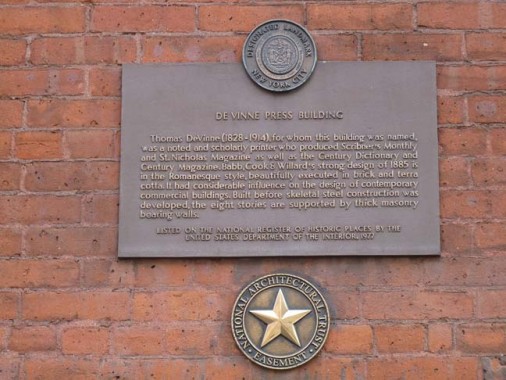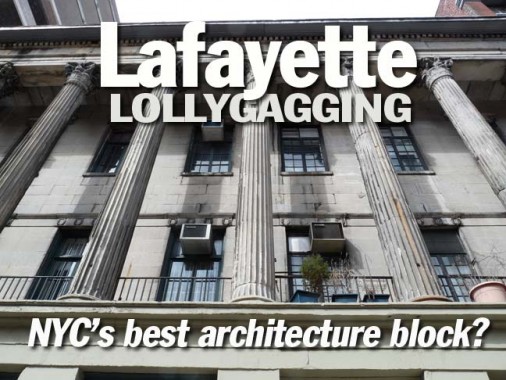I was loitering around Lafayette Street in late March 2013, before and after recording a voice track for the New Museum New York 1993 Pay Phone installations, when it occurred that Lafayette Street between East 4th and Astor has a whole lot of nice-looking buildings. Indeed, many are landmarked, most dating to the 1880-1900 period, and one goes all the way back to 1831. Is there a better single block in Manhattan? Tough competition, I realize, and it depends on what your tastes are.
Lafayette Street, named for the French general who indispensably assisted the American Revolution, is a relatively new addition to the Manhattan map. It was created in the early 1900s by extending it south from the formerly exclusive Lafayette Place (running for one block south of Astor Place) and combining it with the roadbeds of the former Marion and Elm Streets. A cutoff section of Elm Street is today’s Elk Street. Today I’ll take a look at the buildings concentrated on the former Lafayette Place.

The Schermerhorn Building actually can be found a block south of East 4th, on the NW corner of Great Jones Street. It was designed by prolific architect Henry Hardenburgh and built in 1888, a great year for building design. The architect also claimed the Plaza Hotel and the Dakota Apartments among his accomplishments.


DeVinne Press Building, 393-399 on the NE corner of East 4th. When researching the building, from my Photo-Lettering type days I remembered the Bodoni-esque DeVinne type font. Thomas DeVinne was a giant of print on either side of 1900, publishing then-popular but now forgotten magazines such as Scribner’s, Century, and St. Nicholas Children’s Magazine. The DeVinne name was famed for innovative type fonts and high-quality books and magazines.
As the National Register of Historic Places plaque says, the DeVinne Press Building boasts tremendously thick load-bearing walls as the building was completed in 1885, before the era of steel skeletons. Note the five different types of arched windows.
The NW 4th Street corner building, 400 Lafayette, is just another example of the casual excellence of this era’s design. Another one from 1888.
401 Lafayette, center, built 1893, has some engaging copper scrollwork and brownstone ornamentation on the 2nd floor.
411 Lafayette is also called the Durst Building. It features a cast-iron front on the bottom, including two-story columns, and masonry with “echoic” columns between the windows on the three floors above. It is a former men’s clothing store and factory completed in 1894.
The landmarked Colonnade Row (LaGrange Terrace) on today’s Lafayette Street was built from 1831-1833 (on the much shorter and exclusive Lafayette Place) by architect Seth Geer, and originally consisted of nine houses, of which only four remain today. When first built, the houses were occupied by social bright lights of the era such as the Astors and Vanderbilts. Indeed, famed authors Washington Irving, Charles Dickens, William Makepeace Thackeray have all stayed here and President John Tyler got married here on the sly. Since its plummy days, Colonnade Row has been allowed to chip, molt and deteriorate into a fabulous ruin.
Blue Man Group took over a basement space in 1991 and have gradually become a worldwide phenomenon.
The whereabouts of the five missing Colonnade Row buildings had been a mystery, after John Wanamaker, the Philly department store king (see below), bought them and had them removed in the first decade of the 20th Century. It was thought the missing columns and facades were lost forever. It turns out that they have been on the grounds of the Delbarton School, run by St. Mary’s Abbey in Morristown, NJ, for many years.
It’s a tossup about what is the most distinctive building on old Lafayette Place, between Colonnade Row and the Joseph Papp Public Theater, which face off across the old drag. Since the Colonnade hasn’t been taken care of over the years to the degree it should have been, and several units have been carted away, I suppose the Papp should take the prize.
The building was built as the Astor Library and it forms such a cohesive unit today, you wouldn’t think it was completed in stages (1853, 1859, 1881) by three different architects. The Astor Library combined with two other libraries for form the NYPL and this was its flagship building before the literary lions, Patience and Fortitude, took their place at the “new” building on 5th and 42nd in 1912.
In 1967, stage impresario Joe Papp (1921-1991) got the City Council to authorize the purchase of the building in 1967 as the new permanent home of the NY Shakespeare Festival, now the Public Theater. Both the inside and outside of the building were then meticulously rehabilitated.
436-440 seems relatively modern but it is older than it looks; it was on Lafayette Place by 1870 and was constructed for men’s clothier Alfred Benjamin & Co. There are interesting touches like 6 escutcheons (shields) each featuring two eagles and a ram’s head. Gerard Wolfe, in New York: 15 Walking Tours, thinks the haberdasher’s initials can be made out on them, but I don’t see it. There’s also a grand old brass clock left over from Mann Refrigeration’s tenancy in the building.
442-450 Lafayette, on the SW corner of Astor Place, was built in 1875 for publisher J. J. Little, which has since become Little, Brown & Co., now part of the Hachette publishing group.
Fronting the narrow plot on Lafayette between Astor Place and East 8th is the Astor Place Hotel, formerly known as the District 65 union hall, and before that, Clinton Hall and before that, the Mercantile Library, completed in 1892.
This Romanesque Revival building was designed by George E. Harney and constructed by the McCabe Brothers in 1890-92 for the Clinton Hall Association, which installed its Mercantile Library on the sixth and seventh floors. The building was featured in the real estate publications of its day. The mercantile library was founded in 1820 by the· clerks of downtown merchants as a private reference and circulating library. Originally located on Fulton Street, the organization erected the first Clinton Hall in 1830 at Nassau and Beekman Streets, moving in 1854 to the former Astor Place Opera House on the site of the present building. NYC Landmarks Designation Report
Old Clinton Hall also has the distinction of being one of two stations to have a direct entranxce from a subway platforms underneath it. A long bricked-up entrance can be found near the turnstile on the downtown Astor Place platform. (The other such door is on the Times Square Shuttle platform and went to the Knickerbocker Hotel.) The stations were built in the days when you were sold a ticket and gave it to a second person who would take it from you and put it in a ticket chopper.
The building stands on the site of the Astor Place Opera House, where, in 1849, Nativist theatregoers rioted against the appearance of British actor William Macready. 22 “patrons” were killed.
The classic Cooper Union building still anchors Cooper Square as it has done since 1859. The school was founded by inventor Peter Cooper, who laid the first transatlantic cable, ran the first successful railroad, and was the first producer of edible gelatin (the father of Jell-O). The school’s great hall was where Abraham Lincoln launched his presidential campaign in 1860; other speakers have included Mark Twain, Frederick Douglass, Susan B. Anthony and presidents Grant, Cleveland, Taft, Theodore Roosevelt, Wilson, Clinton and Obama.
The college is divided into three schools: the Irwin S. Chanin School of Architecture, the School of Art, and the Albert Nerken School of Engineering. It offers undergraduate and Master’s degree programs exclusively in the fields of architecture, fine arts, and engineering.
Tony Rosenthal’s nearly 1-ton cube-ist sculpture called Alamo, installed in 1967, can rotate if you push it hard enough.
Any discussion of Cooper Square is incomplete without mentioning Jim Power’s lamppost mosaics. Power, a Vietnam veteran who has patrolled the East Village after his return from the war, has lived in various areas in Lower Manhattan with his beloved dog for the last few decades and has found a niche in fine art, decorating the area with ceramic pieces and bits of crockery that he glues onto exterior surfaces.
At first, the applications were purely decorative, but over the last few years, Power has become something of an amateur historian, working the names of personalities and famed buildings of the past and present into his designs. As he becomes older and more infirm, he has taken on a protege named Al Bonsignore, their work has been getting ever more attractive. During the Giuliani era, many of his lamppost works were removed, but today the Department of Transportation practices a brand of benign indifference. He is now able to pursue his passion, which has, as yet, unfortunately not accrued him much income, other than some local businesses hiring him for murals and such.
See FNY’s St. Mark’s Place page for more on Power’s mosaics.
In the early 1980s, the MTA installed a replica of one of the IRT’s classic entrance kiosks. When the IRT subway was first opened in 1904 its stations had dedicated entrance and exit kiosks, with different designated designs. As cars began to dominate the streetscape the bulky kiosks interfered with sightlines and so were gradually removed over time; the last original ones disappeared in the early 1960s. But we have this new one to remind us what they were like.
The orange MUD coffee truck is a familiar fixture outside the Astor Place subway entrance.
The company, started in 2001 by husband and wife team, Greg Northrop and Nina Barott, is known for their coffee as well as their locally-oriented approach to business. This grassroots approach towards conducting sustainable business while remaining faithful to the eclectic nature of the neighborhood has earned MUD the title of official coffee of the Onion, a local satirical newspaper, the endorsement of Reverend Billy, leader of ‘cultural jammers’ the Church of Stop Shopping, as well as secured them a welcome place within the East Village community. wikipedia
MUD also has a second coffee truck at Sheridan Square and a sitdown coffee shop at 2nd Avenue and East 9th Street.
The former John Wanamaker Department Store Annex is one of the few NYC buildings that takes up an entire square block (Macy’s doesn’t). The main store was a block to the north and was demolished decades ago. It was Wanamaker who demolished five units of Colonnade Row to make way for a truck warehouse, which still has his name on it.
The Astor Place subway station still contains an entrance to the store — now a K-Mart (formerly Kresge’s) on the ground floor.
This inscrutable glass-fronted building, 51 Astor Place, is the school’s latest entry in its collection of avant-garde architecture surrounding the school’s 1859 flagship.
The building is the sum of three main sculptural forms: the trapezoidal, dark-glass-clad office space abuts two shapes composed in the lighter glass: a highly regular, light-colored box with a triangular mid-rise piece on top of it. From certain angles, the building will look geological, resembling a pile of jutting, crystalline fragments. From others, it is frustratingly regular-looking and dry….Mr. [Fumihiko] Maki‘s building, unfortunately, doesn’t say much of anything at all, beyond advertising its cool, no-nonsense sense of propriety as an office space. –Robbie Whalen, Wall Street Journal; story is paywalled
Because of overall costs, apparently, beautiful masonry architecture, seen above on Lafayette, is a thing of the past and we will have glass, glass, glass and metal from now on.
At 9th Street, Lafayette begets 4th, which begets Park…
3/27/13
